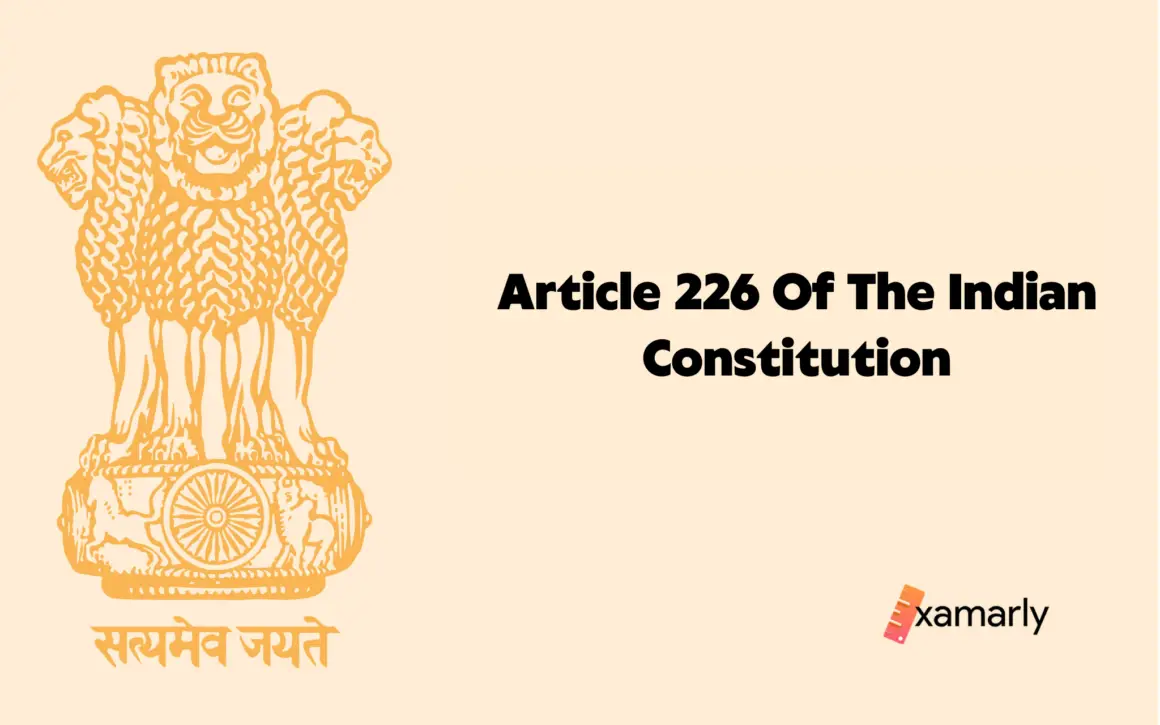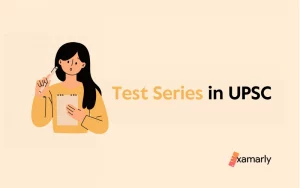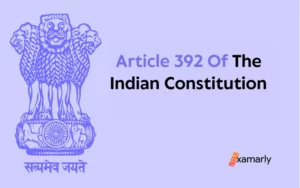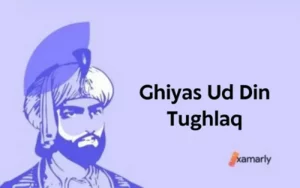Article 226 talks about the authority that the courts have to issue orders, and writs to the government or any individual for the purpose of securing rights, among others.
It talks about the powers and protocols that the High Court also has in relation to Article 32 of the Indian Constitution.
Let us dig deep into Article 226 of the Indian Constitution and grasp all the concepts related to it.
Article 226 of the Indian Constitution – In Detail
To have an in-depth concept of Article 226 of the Indian Constitution, we will break down each and every clause present in it in detail. Let’s get started
Clause 1 – As it is & Explained
(1) Notwithstanding anything in Article 32 every High Court shall have powers, throughout the territories in relation to which it exercise jurisdiction, to issue to any person or authority, including in appropriate cases, any Government, within those territories directions, orders or writs, including writs in the nature of habeas corpus, mandamus, prohibitions, quo warranto and certiorari, or any of them, for the enforcement of any of the rights conferred by Part III and for any other purpose
Clause 1 of Article 226 of the Indian Constitution says that despite anything mentioned in Article 32 of the Indian Constitution, the High Court has the power and authority to issue directions, orders and writs to any individual, authorities or writs.
It also says that High Court can only issue writs, orders or instructions throughout only those areas that it exercises its jurisdiction with respect.
The first clause has also defined the nature of writs that can be exercised. These are in the nature of habeas corpus, mandamus, prohibitions, quo warranto and certiorari.
These writs, instructions or orders are issued to preserve the rights that are granted by Part 3 of the Indian Constitution for any purpose.
Related – Article 236 Of The Indian Constitution: Interpretation
Clause 2 – As it is & Explained
(2) The power conferred by clause ( 1 ) to issue directions, orders or writs to any Government, authority or person may also be exercised by any High Court exercising jurisdiction in relation to the territories within which the cause of action, wholly or in part, arises for the exercise of such power, notwithstanding that the seat of such Government or authority or the residence of such person is not within those territories
According to the second clause of Article 226 of the Indian Constitution, any High Court that has jurisdiction over the territories within which the cause of action, wholly or partially, arises for the exercise of such power may issue directions, orders, or writs to any Government, authority, or person, regardless of whether or not the seat of such Government or authority or the residence of such person is located within the territories.
This is the case even if such Government or authority does not have its headquarters within the territories.
Clause 3 – As it is & Explained
(3) Where any party against whom an interim order, whether by way of injunction or stay or in any other manner, is made on, or in any proceedings relating to, a petition under clause ( 1 ), without
(a) furnishing to such party copies of such petition and all documents in support of the plea for such interim order; and
(b) giving such party an opportunity of being heard, makes an application to the High Court for the vacation of such order and furnishes a copy of such application to the party in whose favour such order has been made or the counsel of such party, the High Court shall dispose of the application within a period of two weeks from the date on which it is received or from the date on which the copy of such application is so furnished, whichever is later, or where the High Court is closed on the last day of that period, before the expiry of the next day afterwards on which the High Court is open; and if the application is not so disposed of, the interim order shall, on the expiry of that period, or, as the case may be, the expiry of the aid next day, stand vacated
The third clause of Article 226 of the Indian Constitution says that to the extent that any party against whom an interim order is made on, or in any proceedings relating to, a petition under clause (1), whether by way of injunction, stay, or otherwise, without prejudice to the merits of the petition, the party shall be deemed to have waived any right to a speedy trial under clause (1).
(a) delivering copies of the petition and any supporting materials to the opposing party; and
(b) giving the such party a chance to be heard, makes an application to the High Court for the vacation of such order and gives a copy of such application to the party in whose favour such order has been made or the counsel of such party, the High Court shall decide the application within two weeks from the date it is received or from the date a copy of the such application is given, whichever is later; or where the High Court has already made a decision on the matter, the application shall be decided within two weeks from the date.
Clause 4 – As it is & Explained
(4) The power conferred on a High Court by this article shall not be in derogation of the power conferred on the Supreme court by clause ( 2 ) of Article 32
The fourth clause of Article 226 of the Indian Constitution says that no High Court’s authority under this article shall be construed as a limitation on the Supreme Court’s authority under Article 32, clause 2.
Comparison of Articles 32 and 226
- While Article 32 guarantees basic protections, Article 226 guarantees them under the Constitution.
- In the event of an emergency, the President may suspend Article 32; however, even in the event of an emergency, Article 226 may not be suspended.
- Since Article 32 is only used in the event of a violation of a fundamental right, its scope is limited. However, Article 226 is more comprehensive in that it addresses both cases of abuse of fundamental rights and violations of legal rights.
- The Supreme Court of India has jurisdiction across India and may issue writs under Article 32. Thus, the Supreme Court’s ability to hear cases from a wider range of locations has been greatly increased. However, the High Court has sole writ power inside its own territory (Article 226). This means that High Court jurisdiction is constrained to a smaller geographic area.
- The Supreme Court cannot overturn Article 32 because it protects fundamental freedoms. Nonetheless, the High Court has the authority to issue writs at its discretion pursuant to Article 226.
Some Popular Judgements Relevant To Article 226 Of The Indian Constitution
- The High Courts’ authority to issue orders, directions, and writs to ensure the protection of legal rights granted to the disadvantaged by statute is recognised as being on par with, if not more important than, the protection of fundamental rights in the case of Bandhua Mukti Morcha v. the Union of India (1984).
- It was determined in Veerappa Pillai v. Raman and Raman Limited (1952) that the writs mentioned in Article 226 were clearly intended to enable the High Court to issue them in cases where subordinate bodies or officers act without jurisdiction, in excess of jurisdiction, in violation of natural justice principles, in refusal to exercise a jurisdiction vested in them, or where there is an obvious error on the face of the record. It does not appear that the High Court’s jurisdiction is wide enough for it to function as a Court of Appeal, evaluating the merits of the disputed rulings and deciding on its own what course of action is appropriate or what order should be made.
- The High Court was ruled to not sit and/or function as an appellate authority against the orders/actions of the lower authorities in the case of Chandigarh Administration v. Manpreet Singh (1991). Only supervisory powers are under its purview. One of the main purposes of the jurisdiction is to confine the government and various other agencies and courts to their own territories. The High Court must be mindful of the limits of its authority when carrying out this function.
- It was decided in Burmah Construction Co. v. the State of Orissa (1961) that petitions filed under Article 226 of the Constitution to enforce a civil liability arising out of a breach of tort or breach of contract to pay an amount due to the claimant are not normally entertained by the High Court, and that the aggrieved party must instead pursue the issue in a civil suit. An order for payment of money may be obtained in a petition under Article 226 against the state or an officer of the state, but only to carry out a statutory duty.
- It was decided in Jagdish Prasad Shastri v. the State of Uttar Pradesh (1970) that a high court can refuse to resolve factual problems raised in a petition for a high prerogative writ and send the party seeking redress back through the regular litigation process if the petition raises issues that the court does not think should be decided in a petition for a writ. It is undeniable that the High Court’s dismissal of the petition on the grounds that there were unresolved issues of fact was wrong.
- In State of Madras v. Sundaram (1964), it was ruled that a High Court exercising its power under Article 226 of the Constitution cannot sit in appeal over the findings of fact made by a competent Tribunal in an adequately conducted departmental investigation unless it can be shown that the impugned conclusions were not supported by any evidence. To be clear, the sufficiency of such evidence to substantiate the claim is not a question before the High Court when it exercises its competence under Article 226 of the Constitution.
- According to the Hon’ble Supreme Court’s decision in Common Cause v. the Union of India (2018), Article 226 of the Constitution gives the High Court the authority to issue writs such as mandamus, certiorari, prohibition, quo warranto, and habeas corpus to ensure the protection of basic liberties and freedoms, among other things. To that end, the High Court can provide relief for “any other cause,” which could include the enforcement of public responsibilities by public agencies.
Summing Up
We can conclude from Article 226 of the Indian Constitution that Article 226 empowers of High Courts to issue certain writs. Writs include writs in the nature of habeas corpus, mandamus, prohibitions, quo warranto and certiorari.
A High Court may also issue directions, orders or writs to any Government, authority or person.
FAQs
Who issues writ under Article 226?
Under Article 226 of the Indian Constitution, writs can be issued by the High Courts of India. Specifically, Article 226 gives the High Courts the power to issue writs for the enforcement of the fundamental rights of citizens, as well as for any other purpose.
The writs that can be issued under Article 226 include habeas corpus, mandamus, prohibition, quo warranto, and certiorari.
These writs are used as legal remedies to address various types of issues, such as unlawful detention, violation of fundamental rights, abuse of power by public authorities, and other forms of judicial and administrative excess.
The power to issue writs under Article 226 is an important aspect of the judicial review power of the High Courts, which enables them to ensure that the actions of the government and other public authorities are consistent with the Constitution and the rule of law.
What are the 5 types of writs?
There are five types of writs that can be issued by the High Courts of India under Article 226 of the Constitution:
Habeas corpus: This writ is used to challenge unlawful detention or imprisonment, and requires the authorities to produce the detained person before the court, so that the court can determine the legality of their detention.
Mandamus: This writ is used to order a public authority or an individual to perform a public duty that they are legally obliged to perform, or to refrain from performing an unlawful act.
Prohibition: This writ is used to prevent a lower court or tribunal from exceeding its jurisdiction or from making an error of law.
Quo warranto: This writ is used to challenge the right of a person to hold a public office, or to question the legality of an authority’s exercise of power.
Certiorari: This writ is used to quash the orders or decisions of a lower court or tribunal, on the grounds that they are illegal or ultra vires (beyond the powers) of the court or tribunal.
Can an appeal be filed under Article 226?
A judgement or order made by a single judge of the High Court in accordance with Article 226 of the Constitution of India may be appealed to a “Division bench” made up of two judges of the same High Court.
Which president suspended the writ?
Lincoln and the army did not follow Taney’s decision. On September 24, 1862, President Lincoln signed a proclamation that stopped everyone in the country from having the right to writs of habeas corpus.
Who can issue a writ for fundamental rights?
In India, writs for the enforcement of fundamental rights can be issued by the High Courts and the Supreme Court. Specifically, the High Courts have the power to issue writs under Article 226 of the Constitution, while the Supreme Court has the power to issue writs under Article 32 of the Constitution.
Article 226 of the Constitution gives the High Courts the power to issue writs in the nature of habeas corpus, mandamus, prohibition, quo warranto, and certiorari, for the enforcement of any of the fundamental rights guaranteed by the Constitution.
This means that if a person’s fundamental rights have been violated by the government or any other public authority, they can approach a High Court to seek a writ under Article 226 as a legal remedy.
Similarly, Article 32 of the Constitution gives the Supreme Court the power to issue writs in the nature of habeas corpus, mandamus, prohibition, quo warranto, and certiorari, for the enforcement of any of the fundamental rights guaranteed by the Constitution.






